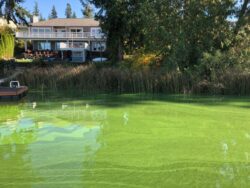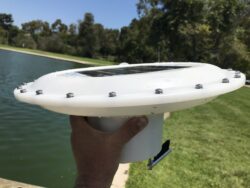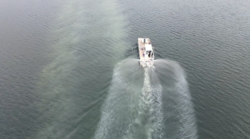 Aquatechnex is known in Washington State primarily for our expertise in managing invasive aquatic weeds such as Eurasian milfoil. A large part of our business, however, is outside Washington and we are often more focused on managing and mitigating harmful algae blooms (HABs).
Aquatechnex is known in Washington State primarily for our expertise in managing invasive aquatic weeds such as Eurasian milfoil. A large part of our business, however, is outside Washington and we are often more focused on managing and mitigating harmful algae blooms (HABs).
Cyanobacteria infestations are on the rise as lakes age and climate change contributes to warmer waters in the West. The toxins produced by these species have long been known for the acute poisoning of wildlife and pets, and they also pose a human health threat. As scientists continue to study HABs, they are finding that these toxins can aerosolize and travel some distance from a lake. The University of Florida recently found that microcystin toxins had carried 10 miles downwind from an impacted lake in light winds. Clearly, these blooms pose a threat and, where possible, should be managed. Aquatechnex is doing this in a couple of ways.
Aquatechnex is partnered with EutroPHIX, a new division of the SePRO Corporation (Sepro.com). This national effort will help develop an awareness of HAB problems and help groups develop effective solutions. We will be working with EutroPHIX in the western US. As part of their effort, the company is deploying a new technology to intercept phosphorus in incoming waters to lakes and reservoirs, as well as to use as part of several in-lake restorative measures. They also have a new algaecide pending US EPA registration (expected in the first quarter of 2021) that targets HABs and oxidizes toxins present in the water column.
One of Aquatechnex’s successful projects involved managing HABs in the 900-acre terminal reservoir for the California Aqueduct. Levels of HABs present halted the delivery of potable water to more than five million customers in southern California; the peroxygen algaecide treatment worked within 24 hours and the drinking water plants were able to resume operations.
Our southern California team has recently deployed a number of low-cost monitoring buoys that can track both chlorophyll a and phycocyanin, which is a pigment unique to cyanobacteria species. We have placed these in lake systems historically treated for HAB conditions. The buoy system reports data to a desktop via cellular network and we can see blooms starting to develop before a full-blown bloom occurs. We can dispatch treatment teams to deal with the bloom before it expands, allowing us to keep lakes open and safe. We also use less algaecide with this system, because we can address the problem when biomass is low. More information is available at Aquatechnex
Many heard about the potential of nanobubble generators at the recent WALPA and NALMS meetings (see related story on this technology). Aquatechnex has been following this technology and we feel it holds promise in several situations. In the spring of 2020, we purchased and installed two nanobubble generators on a lake in the Orange County Park System (in southern California) with historic HAB problems. We have monitored 15 water quality parameters including algae id and enumeration at this site for several years and are starting to see promising results. While these systems may not work in every situation, we are looking forward to learning from this project and seeing where nanobubblers may be effective in the future.
Lastly, this spring we performed a Phoslock application on 245-acre Kitsap Lake, another lake with a history of HAB problems. Phoslock is a technology that sequesters and removes free reactive phosphorus from the water column which lowers the carrying capacity of a lake to develop HAB blooms. Secchi disc readings all summer averaged 14 feet. This program will extend into 2021.
For more information on our group, www.aquatechnex.com













